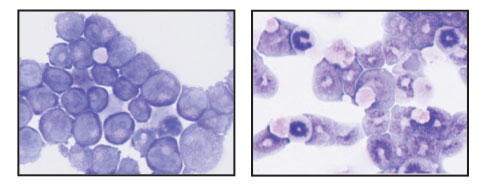New research reveals potential for new targeted cancer treatment
Researchers at the University of Copenhagen’s Biotech Research and Innovation Centre (BRIC) has shown that leukaemia cells depend on a group of enzymes to survive. By inactivating these enzymes, researchers can kill the leukaemia cells. Small molecule inhibitors that can block the enzymes’ activity will therefore have considerable potential for treating leukaemia. The results have just been published in the journal Genes and Development
- In our research project, we have produced a mouse model of human leukaemia. In this model, by means of genetic changes, we have artificially closed down the function of some enzymes called Jmjd2. This stops the development of leukaemia in the mice, and they survive. This means that if you block the activity of the Jmjd2 enzymes, you have the potential to develop a better treatment of patients with leukaemia,” explains Associate Professor Karl Agger.
The Jmjd2 enzymes’ function in cancer
The Jmjd2 enzymes were first identified 10 years ago by Professor Kristian Helin’s research group at BRIC, where the new discoveries have also been made. The enzymes represented a new class of enzyme which, simply put, can reverse the normal development of cells by changing which genes are active. Prof. Helin’s group also showed that the enzymes were present in very large quantities in certain types of cancer cells. The discovery was published in the journal Nature. This, along with subsequent publications by the research group, led to the establishment of the biotech company EpiTherapeutics, whose aim was to develop substances that, among other things, could block the Jmjd2 enzymes’ activity. Last year, EpiTherapeutics was sold to the American pharmaceutical company Gilead Biosciences for 65 million US dollars.

Leukemic cells before (left) and after (right) inactivation of the Jmjd2 proteins
The Helin group’s new results show that the Jmjd2 proteins regulate the activity of a specific gene that codes for a growth factor receptor located on the surface of cells. This receptor is required for the leukaemia cells to grow, and if the Jmjd2 proteins’ function is inactivated, these cells do not receive their normal signals, and die. The new results thus suggest that it is possible to treat a specific form of cancer by using specific chemical inhibitors that can block the function of the Jmjd2 proteins. This is an example of a potential personalised and targeted cancer treatment in which in-depth knowledge of the leukaemia cells’ molecular changes can be used to determine the potentially best treatment.
Hope for new treatment
However, Professor Kristian Helin stresses that the researchers still have a way to go before they can offer cancer patients a new treatment:
- There are a number of biotech companies, including EpiTherapeutics/Gilead Biosciences, that have already developed small molecule inhibitors that can block the activity of the Jmjd2 enzymes, but these inhibitors have not yet been used in clinical trials. The hope is that clinical trials will start next year, and after that we’re probably looking at a timeframe of 5 to 10 years before inhibitors can be used as the regular treatment of patients with leukaemia.
Related News
Contact
Professor Kristian Helin
Email: Kristian.Helin@bric.ku.dk
Phone: +45 35 32 56 68
Associate Professor Karl Agger
Email: Karl.Agger@bric.ku.dk
Phone: +45 35 33 50 20
Communications Officer Anne Rahbek-Damm
Email: anne.rahbek@bric.ku.dk
Phone: +45 21 28 85 41
